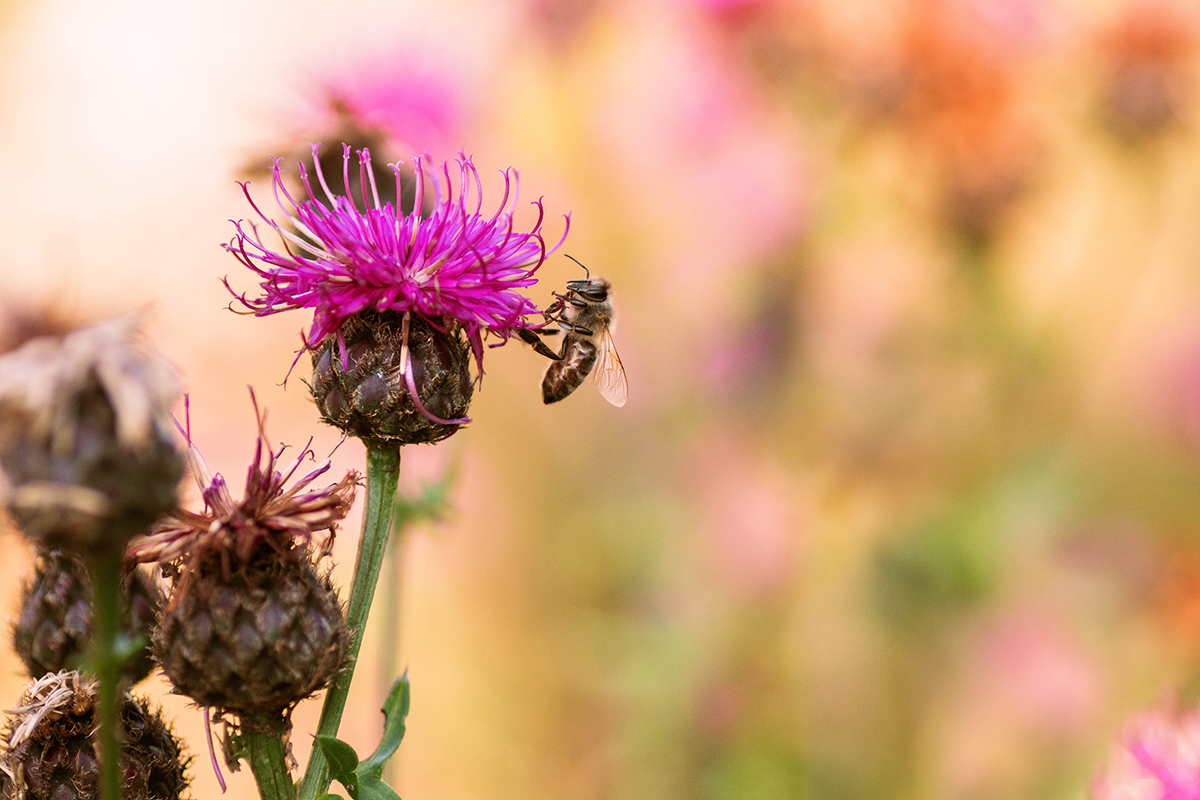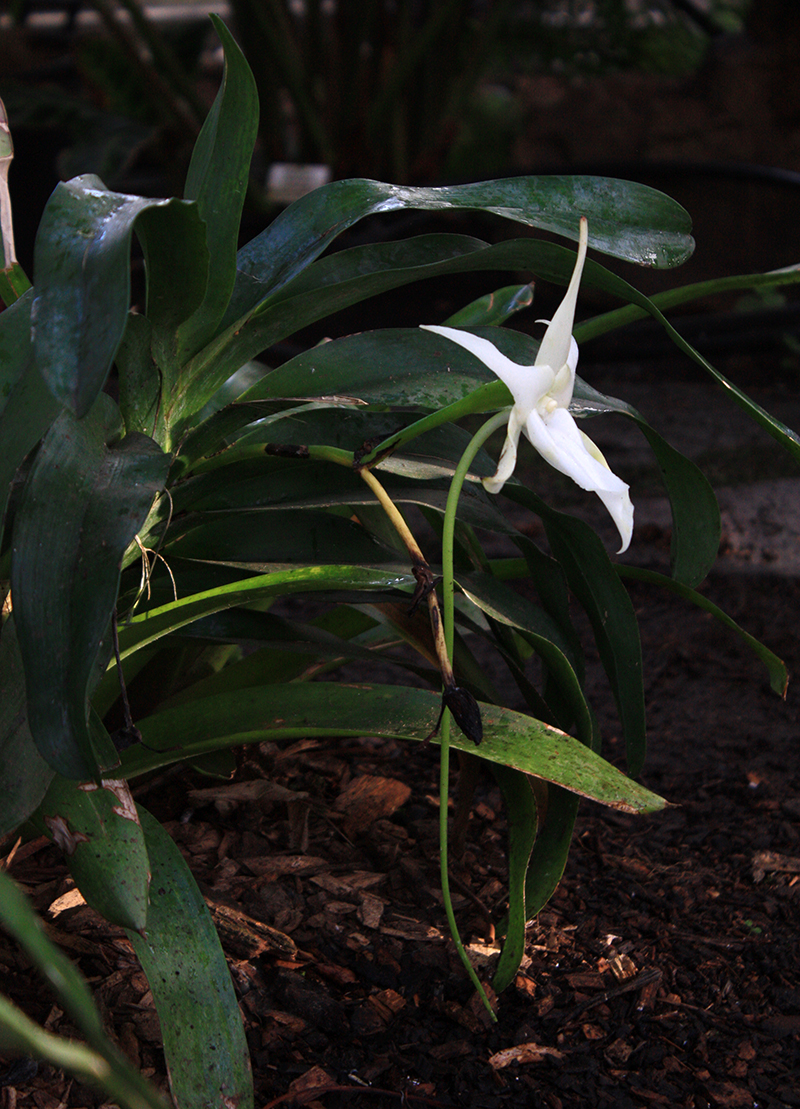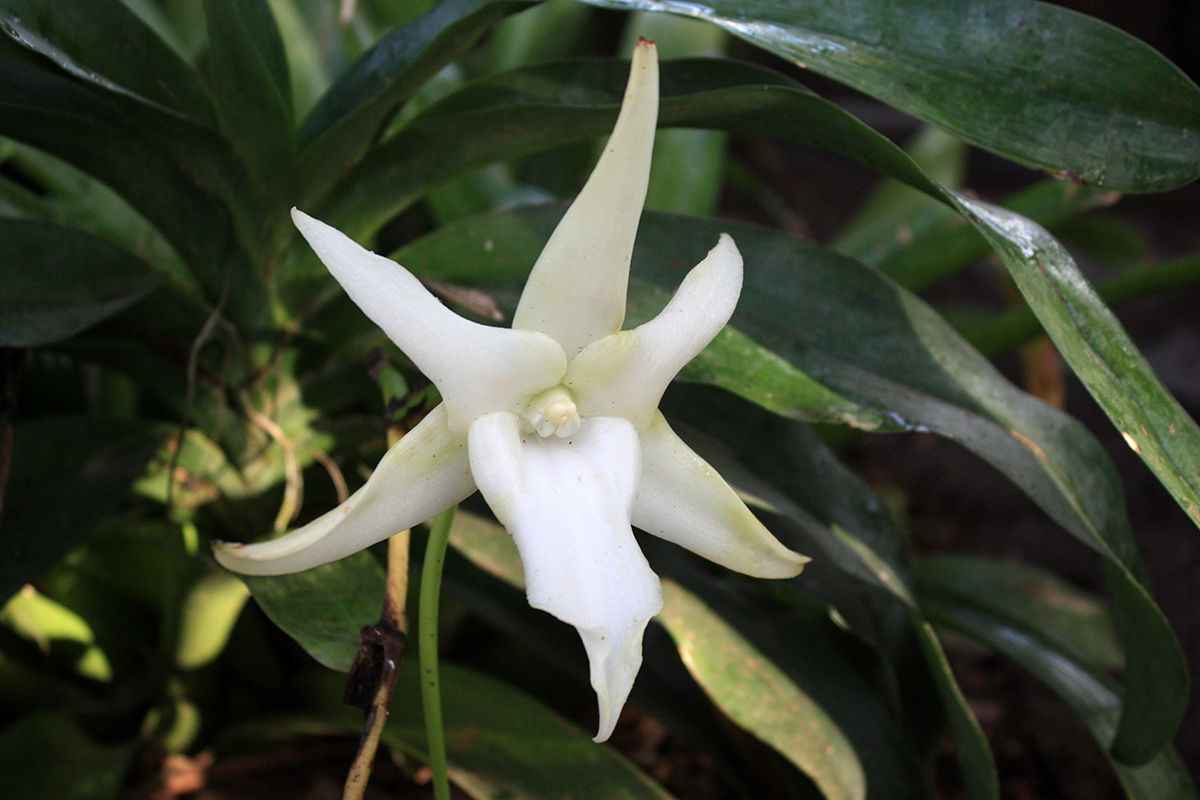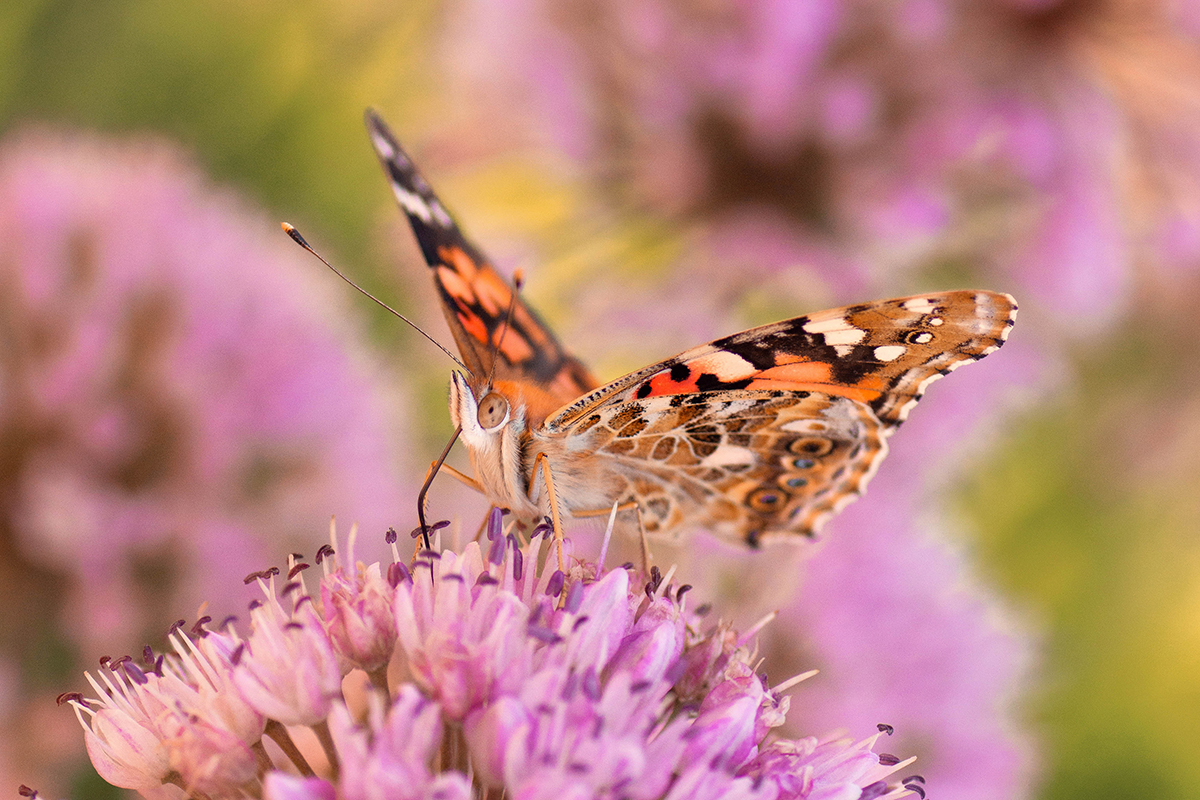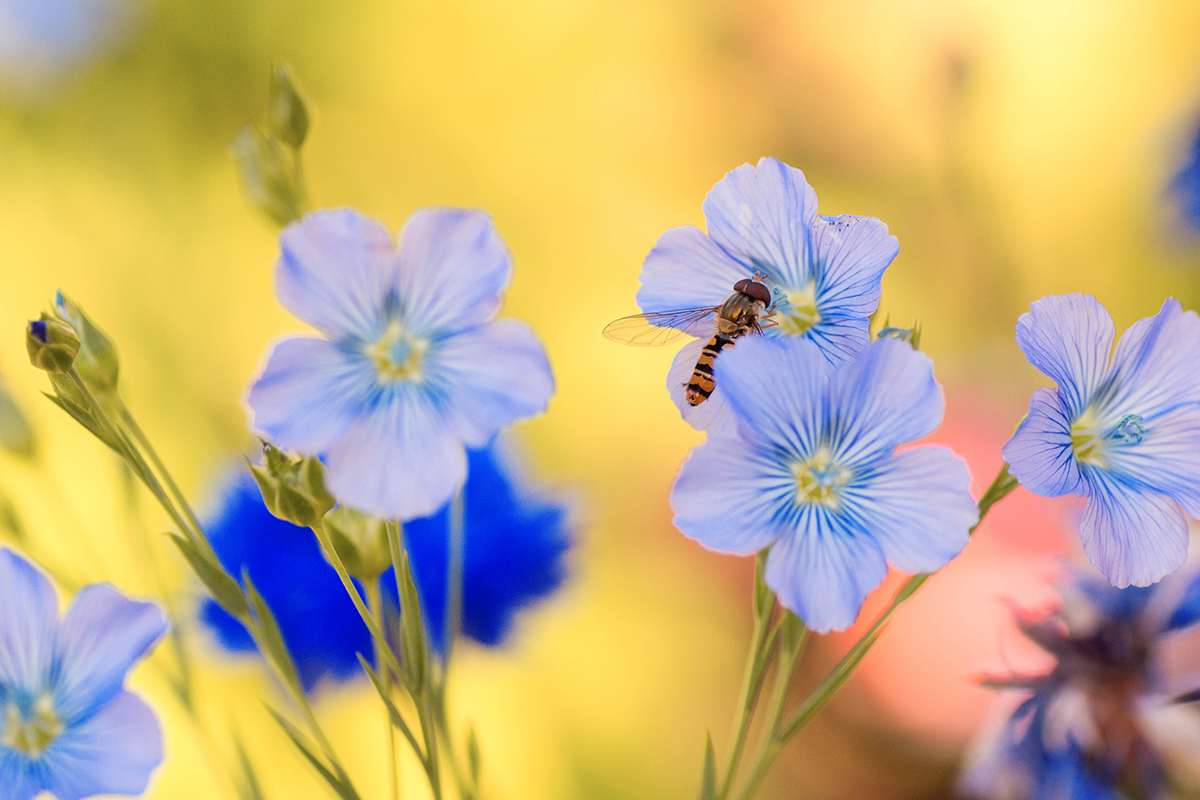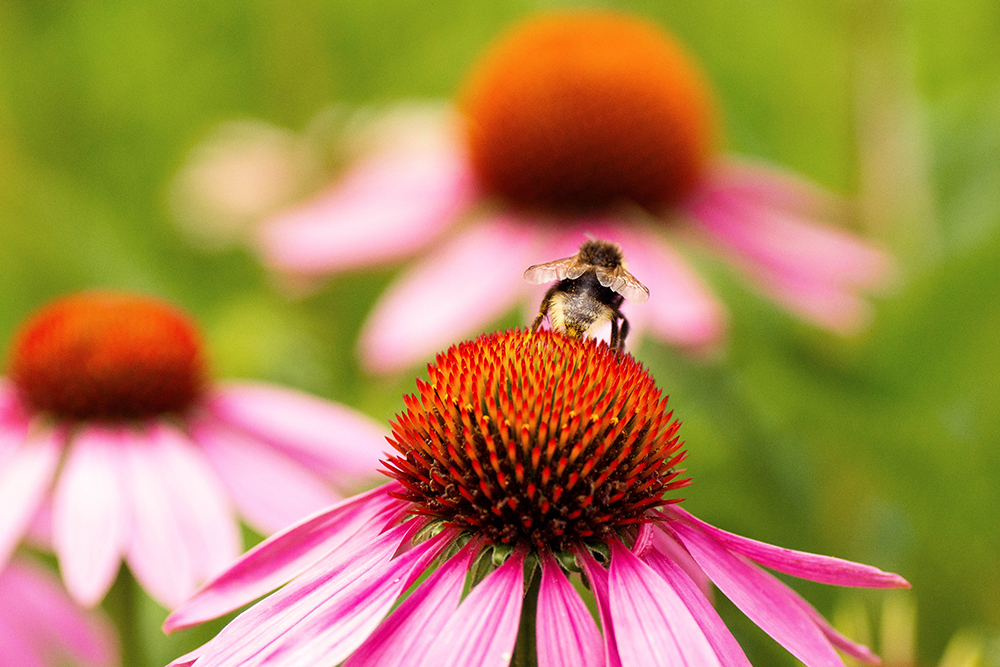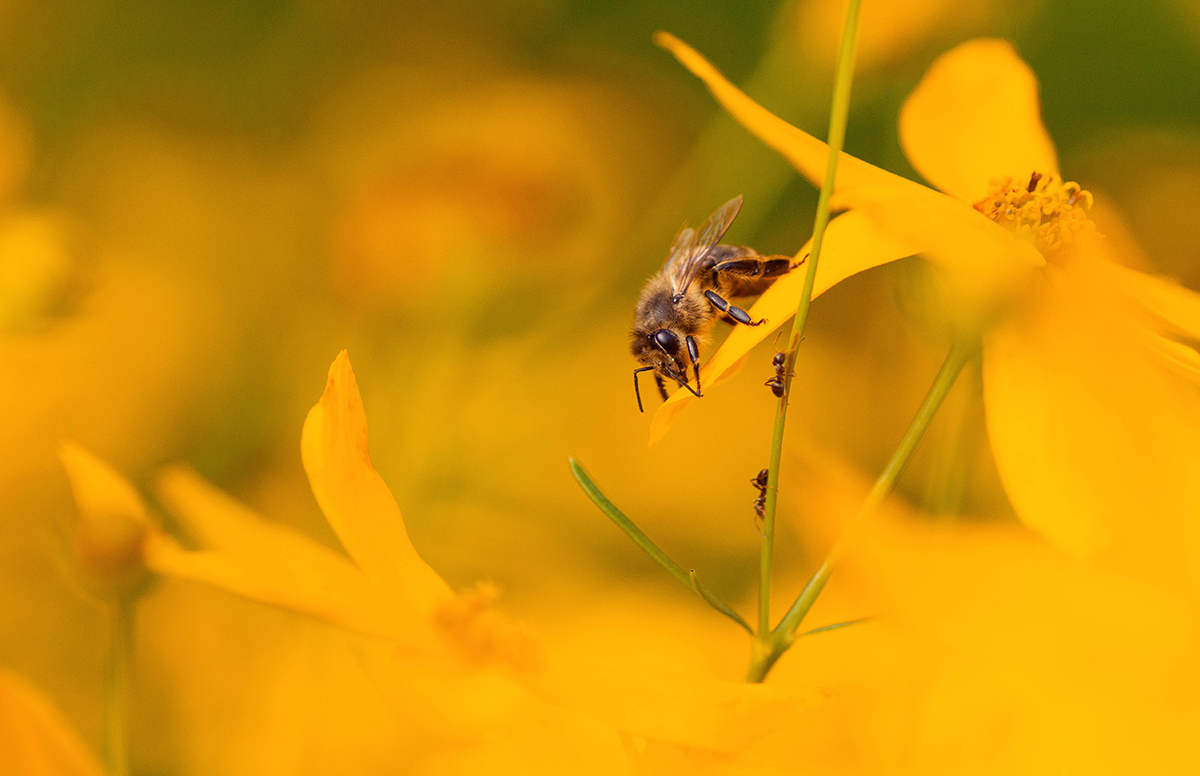Plant Pollination by Insects
Insect pollination of flowers is a highly important ecosystem service throughout many of the world’s ecosystems. Of the planet’s 300,000 species of flowering plants (angiosperms), approximately 80% depend on some form of insect-mediated pollination. Without this essential service, many plants would be unable to create the seeds necessary to germinate future generations of plants. Insect pollination has evolved from a deep interdependence between plants and insects that explains many of their peculiar characteristics. Insect pollination is currently under threat from a variety of sources. Knowledge regarding the extent of the pollinator decline is still developing, but many key findings have emerged which help explain the loss of insect pollinators and recommend counteractions.
Pollination by insects is mutually beneficial to both the plants and pollinating insects. Pollination helps plants spread their genetic material contained within pollen grains to other plants of the same species, effectively allowing genes of immobile plants to traverse great distances on the backs (or legs) of insects. Plants usually offer nectar and other beneficial substances to insects as rewards for their visit. Nectar contains carbohydrates, which otherwise might be rare in a particular ecosystem. In addition, insects can use the protein, fat, minerals, vitamins, and other important phytochemicals located in the pollen grains. In utilizing these resources, insects and plants have established a deep interdependence that has fundamentally shaped nearly every non-marine ecosystem on the planet.
Insect pollination is also of tremendous importance to humans. Of the agricultural crops consumed by humans, approximately 36% require animal pollination and up to 75% benefit from it. Humans often use pollination as an ecosystem service, as well as a production practice. As an ecosystem service, wild bees, moths, butterflies, beetles and flies pollinate crops from natural ecosystems that are usually adjacent to agricultural areas. As a production practice, humans use specifically domesticated species such as the honey bee (Apis mellifera) to pollinate crops in areas where there are insufficient natural pollinators. Both the ecosystem service and production practice are of significant value to modern day agricultural activities. Certain crops, such as almonds (Prunus dulcis), cannot produce any crops on their own without the help of honey bees. California, for example, requires two million honey bee colonies each year to support its agricultural output of roughly 76% of the world’s supply of almonds. Other crops such as coffee (Coffea arabica and C. canephora) or cotton (Gossypium hirsutum) either require pollination by insects, or are greatly enhanced by it.
Many crops such as apples, strawberries, and sweet peppers greatly benefit from pollination and it is known to improve fruit size and quality. Frequent visits by pollinators have been directly linked with the number of seeds set by various plants and is of great interest to agriculturalists. For example, strawberries have been shown to produce many useful hormones after fertilization by wild bees, which improve strawberry firmness and increase the acid-sugar ratio. These improvements also increase the shelf-life of strawberries, which is of great importance because 90% of strawberries may be non-marketable after just four days of storage. Bee pollination has been shown to increase shelf-life by as much as 24 hours compared to self-pollinated strawberries and potentially reduce overall food waste of strawberries by 11%. Identifying the extent of required pollination is an active area of research and has provided significant impetus for protecting natural pollinators and the ecosystems that they inhabit.
The evolution of angiosperms during the early Cretaceous (125 million years ago) set the stage for the development of insect pollination. Charles Darwin noted the evolution of flowering plants in a letter dated July 22, 1879 calling it an “Abominable mystery” due to the sudden rise of angiosperms in the geological record and the significant global ecological implications of the displacement of the previously dominant gymnosperms and ferns. By the Cenozoic (65 million years ago) bees, wasps, moths, and butterflies had all evolved and it is at this time that many of the flowers that exist today first appeared. While the exact explanation for Darwin’s mystery may still be elusive, it is now believed that insects have played an important role in the rapid radiation of modern flowering plants that can be seen today.
Many spectacular examples of the close interdependence of flowering plants and insects exist. One such example applies to the bee orchid (Ophrys apifera) and the long-horned bee (Eucera longicornis). The bee orchid has evolved to look and smell like female long-horned bees, therefore attracting their males as the orchid’s sole pollinator. The capability of the bee orchid to outcross (share its genetic material with other bee orchid plants) is greatly reduced without the presence of long-horned bees to act as pollinators. Therefore, throughout much of its northern range, the bee orchid is not pollinated by insects and instead self-pollinates. Self-pollination, or the process of a plant using its own pollen to fertilize itself, has the advantage of allowing a plant to live in an area without depending on its highly specialized pollinator, but the disadvantage of creating offspring that are genetically similar to their single parent plant and are therefore more susceptible to disease and the impacts of a changing environment.
Another example of the remarkable interdependency of plants and insects is one predicted by Darwin himself. In 1862, Charles Darwin received a box from a well known orchid collector at the time. In the box, Darwin noted a particularly striking orchid from Madagascar. The orchid known as Darwin's orchid (Angraecum sesquipedale) was notable because of its extremely long spur (an outgrowth connected to the flower and typically holding nectar) and provoked the prediction that there should be a moth with a proboscis of at least equal length somewhere yet undiscovered. At the time, Darwin’s prediction was received with great skepticism until in 1903, such a moth that perfectly fit his description was found. The moth named Xanthopan morganii praedicta—for the fact that its existence was predicted—is a classic example of coevolution. Coevolution, or the adaptive process of two species having their evolutionary pathways closely linked together, describes the relationship of A. sesquipedale and X. morganii praedicta. As the interests of the orchid and moth competed against each other, a so-called arms race occurred. In this particular case, the orchid tended to limit the amount of nectar it shared with moths by extending its spur further and further, which in turn selected for moths with longer and longer proboscis. Eventually, the two species became so extreme in their adaptations that they became dependent on each other and could not get the service from other species any longer. Such interdependent, coevolutionary relationships are common throughout nature and help explain many of the peculiar traits of certain flowers and insects.
Pollination is the transfer of pollen from the male part of a flower (stamen) to the female part (pistil). The pistil consists of the stigma and the style (conduit holding the stigma and connecting it to the ovary). The process occurs either on the same plant (self-crossing) or between different plants of the same species (outcrossing). While the pollen is developing in the stamen, it is dehydrated, which makes it easier for the wind and insects to carry it to other flowers. Pollen grains have rough, porous outer walls (called exine), which contain a wide diversity of substances, whose functions are not fully understood. These substances however, are of great medical interest and principally responsible for the allergenic quality of pollen. The exine may also be important for the adhesion of the pollen grains to insects and other animals as they transfer them to other flowers.
Once the pollen grains reach the surface of the stigma, many plants utilize specialized proteins within the pollen coat to signal that the pollen is either self, or non-self. Other plant species may utilize different mechanisms to limit the rate of self-crossing, such as offsetting the timing of the development of the male and female parts of the flower. Plants typically require hundreds of pollen grains to be present near the stigma before germination is allowed to occur and is therefore pollen density-dependent. Once enough pollen is present, rehydration occurs and pollen tubes begin to develop. Pollen tubes then extend from the stigma to the embryo sac, which allows for the transfer of the sperm cells to the ovule, where the egg cells reside. Once this has fertilized the egg cells, new seeds can be created and dispersed by the plant to propagate a new generation of plants.
Underlying the mechanism of pollination is a highly developed system of attraction utilizing various visual, chemical, and physical cues to signal the availability of pollen to animal pollinators. Frequently, plants utilize colors that are highly conspicuous to their targeted pollinators as a clear signal of their presence. Most insects (such as bees) are known to be limited to only seeing blue, yellow, and ultraviolet light. Therefore, plants that specialize in being pollinated by insects tend to utilize these colors.
One example that illustrates the color preferences of pollinators is crimson monkeyflower(Mimulus verbenaceus) from North America. The flower exists in red, orange, and yellow morphs. The red morph is the dominant morph and is also the most common. The yellow morph forms from the presence of a single pair of genes and the orange morph is an intermediate form in between red and yellow. Bees have been shown to strongly prefer the yellow morph and to discriminate against the orange and red ones. Hummingbirds however, have been shown to discriminate against the yellow flowers and prefer the red and orange ones. By doing so, the hummingbirds and bees can limit competition (something all organisms tend to do) and establish unique ecological niches which correspond to their particular adaptations for seeing different colors. This example illustrates differences in color preferences between different species, and the flexibility plants have to target different kinds of pollinators.
Insect pollination as an ecosystem service is currently under threat from a variety of sources. Among the best known of these threats has been the widespread impact of colony collapse disorder (CCD) in bee populations. From the period of 2006–2013, as many as 10 million beehives were lost worldwide, which amounts to losses at twice the normal rate. CCD is thought to contribute to the loss of colonies by inducing a mass die-off of the worker bees, leaving only the queen and a few nursery bees in the colony, besides the brood. While the exact mechanism of worker bee die-off is not fully understood, many causes have been implicated. Chiefly among these are neonicotinoid insecticides, which as of 2018 have been banned for outdoor use by the European Union. Neonicotinoids are thought to confuse and disorient the natural homing ability of worker bees, which might explain why they are not typically found dead inside of beehives, but are simply missing. Also, neonicotinoids may have sublethal effects on bees that build up overtime and are not explained by just a single exposure. The effects can also be influenced by other substances, such as fungicides, which can double their lethal effects. Clearly, neonicotinoids are an important part of explaining CCD, but they are only one part of a complicated story that is still unfolding. Other contributing factors are likely climate change, infections by pathogens, malnutrition, and habitat loss.
Significant attention has been given to the declining bee populations in the United States and Europe, but recent findings indicate losses include all flying insects. Findings from Germany suggest flying insect biomass may have declined by as much as 76% in only 27 years. These striking findings, which come from a multi-decade dataset from 63 nature protection areas, are among the clearest indications that insect populations are in decline and that humans are to blame. The findings are perhaps even more significant because the reduction in abundance is far greater than the 58% decline that has been observed in wild vertebrates over the last 42 years. In addition, the decline in insect biomass does not seem isolated to a particular group of flying insects, but instead appears to be devastating the entire community. Proposed explanations for the decline in biomass include familiar causes such as climate change, intensive land use, and the overuse of fertilizers and pesticides.
Such losses in insect biomass have significant implications for the future of ecosystem services performed by insects, such as pollination. Moreover, the entire balance of the food web within the biosphere is threatened by the loss of insect abundance. Not only are insects vital for pollinating many agricultural crops that are essential to feed humanity, but they provide a critical trophic link between energy captured from the sun in the starches and sugars of plants and the rest of the food web. By eating plants and becoming prey themselves for so many other animals, insects contribute to trophic food webs, whose services are invaluable to not just humans but all terrestrial life.
Given the significant threats to ecosystem services like insect pollination, scientists have advocated for major changes. The necessity to protect honey bees has gained significant public attention, but recently the importance of the ecosystem services provided by wild bees and other insects has also risen as one of the most pressing environmental issues of our time. Work is currently being done to further fathom the causes of pollinator decline. Chemicals such as insecticides and fertilizers, which are associated with the intensification of agriculture, negatively impact flying insect populations. Limiting their usage is of critical importance. Curbing the rate of habitat loss has also emerged as a way to improve the conditions for insects. Significant work is being done to better understand the habitat requirements of insects and to increase their protection status within the European Union and elsewhere.
Moreover, mitigating the impacts of climate change is likely to improve conditions for more sensitive species. Bumblebee populations of the genus Bombus, for example, are cool-climate specialists and have been shown to decline in response to rising temperatures. Other species, however, increase in abundance in response to the changing climate, indicating that in future species assemblages of various ecosystems certain species may be favored over others.
An additional issue is climate-change induced desynchronisation of partners that need to interact during a specific time interval. In late winter 2019, unusually high temperatures over one week caused fruit trees to flower in western Germany several weeks in advance of the usual flowering period. At that time, natural insect pollinators as well as honey bees were not yet ready to leave their nests, so most fruit trees stayed unpollinated and did not produce fruit. During this season, honey bee populations suffered from a lack in essential nutrients provided by fruit tree pollen that could not be gathered that year.
What impact such changes will further have on ecosystem services like pollination remains to be seen, but following the precautionary principle as advocated by the European Union, complete scientific understanding of any detail is no prerequisite to take measures now which may effectively prevent environmental degradation.
Arditti, J., Elliott, J., Kitching, I. J. & Wasserthal, L. T. (2012). ‘Good Heavens what insect can suck it’—Charles Darwin, Angraecum sesquipedale and Xanthopan morganii praedicta. Botanical Journal of the Linnean Society, 169(3), 403–432.
Brittain, C., Williams, N., Kremen, C. & Klein, A. M. (2013). Synergistic effects of non-Apis bees and honey bees for pollination services. Proceedings of the Royal Society B: Biological Sciences, 280(1754), 20122767.
Davies, T. J., Barraclough, T. G., Chase, M. W., Soltis, P. S. & Soltis, D. E. & Savolainen, V. (2004). Darwin's abominable mystery: insights from a supertree of the angiosperms. Proceedings of the National Academy of Sciences, 101(7), 1904–1909.
Fenster, C. B. & Marten-Rodriguez, S. (2007). Reproductive assurance and the evolution of pollination specialization. International Journal of Plant Sciences, 168(2), 215–228.
Friis, E. M., Chaloner, W. G. & Crane, P. R. (1987). The origins of angiosperms and their biological consequences. CUP Archive.
Gallai, N., Salles, J. M., Settele, J., & Vaissière, B. E. (2009). Economic valuation of the vulnerability of world agriculture confronted with pollinator decline. Ecological economics, 68(3), 810–821.
Hallmann, C. A., Sorg, M., Jongejans, E., Siepel, H., Hofland, N., Schwan, H., et al. & Goulson, D. (2017). More than 75 percent decline over 27 years in total flying insect biomass in protected areas. PloS one, 12(10), e0185809.
Hoehn, P., Tscharntke, T., Tylianakis, J. M. & Steffan-Dewenter, I. (2008). Functional group diversity of bee pollinators increases crop yield. Proceedings of the Royal Society B: Biological Sciences, 275(1648), 2283–2291.
Lord, E. M. & Russell, S. D. (2002). The mechanisms of pollination and fertilization in plants. Annual review of cell and developmental biology, 18(1), 81–105.
Ollerton, J., Winfree, R. & Tarrant, S. (2011). How many flowering plants are pollinated by animals? Oikos, 120(3), 321–326.
James, R., James, R. R. & Pitts-Singer, T. L. (Eds.) (2008). Bee pollination in agricultural ecosystems. Oxford University Press on Demand.
Klatt, B. K., Holzschuh, A., Westphal, C., Clough, Y., Smit, I., Pawelzik, E. & Tscharntke, T. (2014). Bee pollination improves crop quality, shelf life and commercial value. Proceedings of the Royal Society B: Biological Sciences, 281(1775), 20132440.
Kremen, C. & Ostfeld, R. S. (2005). A call to ecologists: measuring, analyzing, and managing ecosystem services. Frontiers in Ecology and the Environment, 3(10), 540–548.
Kremen, C., Williams, N. M., Aizen, M. A., Gemmill‐Herren, B., LeBuhn, G., Minckley, R., et al. & Vázquez, D. P. (2007). Pollination and other ecosystem services produced by mobile organisms: a conceptual framework for the effects of land‐use change. Ecology letters, 10(4), 299–314.
Rhodes, C. J. (2018). Pollinator decline—an ecological calamity in the making? Science Progress, 101(2), 121–160.
Schiestl, F. P. & Johnson, S. D. (2013). Pollinator-mediated evolution of floral signals. Trends in Ecology & Evolution, 28(5), 307–315.
Serrano, A. R. & Guerra-Sanz, J. M. (2006). Quality fruit improvement in sweet pepper culture by bumblebee pollination. Scientia Horticulturae, 110(2), 160–166.
Stein, K., Coulibaly, D., Stenchly, K., Goetze, D., Porembski, S., Lindner, A., Konaté, S. & Linsenmair, E. K. (2017). Bee pollination increases yield quantity and quality of cash crops in Burkina Faso, West Africa. Scientific Reports (2017) 7:17691, DOI:10.1038/s41598-017-17970-2, http://rdcu.be/CkYB.
Stein, K., Stenchly, K., Coulibaly, D., Pauly, A., Dimobe, K., Steffan-Dewenter, I., Konaté, S., Goetze, D., Porembski, S. & Linsenmair, K. E. (2018). Impact of human disturbance on bee pollinator communities in savanna and agricultural sites in Burkina Faso, West Africa. Ecology and Evolution, 8(13): 6827–6838.
Thomas, V. G. & Kevan, P. G. (2012). Insect pollination: commodity values, trade and policy considerations using coffee as an example. Journal of Pollination Ecology, 7.
Vickery Jr, P. K. (1992). Pollinator preferences for yellow, orange, and red flowers of Mimulus verbenaceus and M. cardinalis. Great Basin Naturalist, 52(2), 5.
Text: Toby Weisenhaus, Dr. Dethardt Goetze


